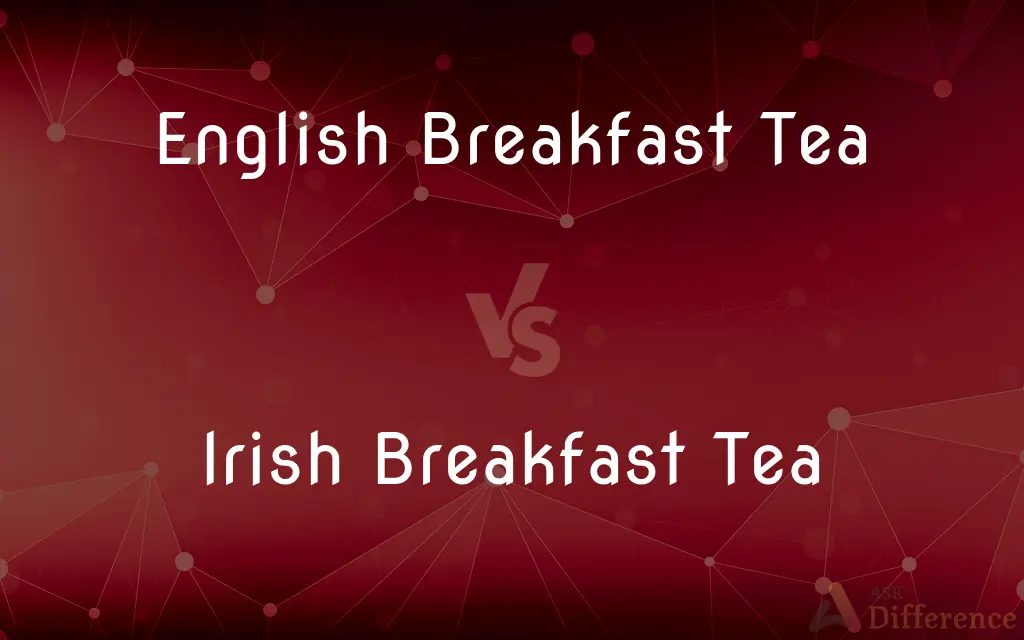English Breakfast Tea vs. Irish Breakfast Tea — What's the Difference?
By Urooj Arif & Maham Liaqat — Published on November 15, 2024
English Breakfast Tea is a blend designed for a hearty, robust start to the day, while Irish Breakfast Tea is even stronger and more intense, often with a higher proportion of Assam tea.

Difference Between English Breakfast Tea and Irish Breakfast Tea
Table of Contents
ADVERTISEMENT
Key Differences
English Breakfast Tea, known for its full-bodied, rich, and robust flavor profile, is a blend of several black teas, commonly including Assam, Ceylon, and Kenyan teas. It's designed to complement a traditional English breakfast, offering a hearty and invigorating start to the day. In contrast, Irish Breakfast Tea, often characterized by a higher proportion of Assam tea, presents a more intense and stronger flavor, making it a bolder choice that stands up well to milk and sugar.
While English Breakfast Tea provides a balanced and mellow flavor suitable for any time of the day, Irish Breakfast Tea's malty and astringent notes cater to those preferring a more potent tea experience. This distinction makes Irish Breakfast Tea particularly popular for those seeking a substantial morning pick-me-up.
The brewing methods for both teas are similar, with boiling water and a steeping time of 3-5 minutes recommended to achieve the perfect cup. However, due to its stronger flavor profile, Irish Breakfast Tea might require a slightly shorter steeping time for those sensitive to astringency.
In terms of caffeine content, both teas offer a significant amount, but the higher Assam content in Irish Breakfast Tea may lead to a slightly higher caffeine level, contributing to its reputation as a more robust stimulant.
Culturally, both teas play a significant role in their respective breakfast traditions, serving not just as beverages but as integral parts of a morning ritual. English Breakfast Tea is often associated with a gentler, more refined morning experience, whereas Irish Breakfast Tea aligns with a more robust, energizing start to the day.
ADVERTISEMENT
Comparison Chart
Flavor Profile
Full-bodied, rich, and robust, but relatively mellow
Stronger, more intense with pronounced malty notes
Common Blends
Assam, Ceylon, and Kenyan teas
Higher proportion of Assam tea
Best Consumed
Any time of day, often with breakfast
Morning, for a strong caffeine kick
Brewing
Boiling water, 3-5 minutes steeping
Boiling water, may require less steeping time
Caffeine Content
Moderate to high
Slightly higher due to more Assam tea
Cultural Context
Complements traditional English breakfast
Associated with a hearty, energizing Irish breakfast
Compare with Definitions
English Breakfast Tea
Steeped with boiling water for 3-5 minutes for optimal flavor.
She steeped her English Breakfast Tea for four minutes, achieving the perfect strength.
Irish Breakfast Tea
Characterized by its intense, bold taste and astringency.
The bold flavor of the Irish Breakfast Tea was invigorating, with distinct malty notes.
English Breakfast Tea
Known for its full-bodied taste, suitable for starting the day.
The rich flavor of her English Breakfast Tea was the perfect morning pick-me-up.
Irish Breakfast Tea
Predominantly Assam tea, known for its strong, malty character.
The high Assam content in her Irish Breakfast Tea gave it a rich, deep color and intense flavor.
English Breakfast Tea
A traditional blend of black teas offering a rich and robust flavor.
He enjoyed a cup of English Breakfast Tea with his morning toast and jam.
Irish Breakfast Tea
Best brewed with boiling water, potentially for a shorter time to manage astringency.
He brewed his Irish Breakfast Tea for just three minutes to soften its robust edge.
English Breakfast Tea
A staple in British morning routines, complementing a hearty breakfast.
Sunday mornings were incomplete without a full English breakfast and a pot of English Breakfast Tea.
Irish Breakfast Tea
A robust blend of black teas, often with a high proportion of Assam, known for its strength.
His Irish Breakfast Tea was strong and malty, exactly how he liked it.
English Breakfast Tea
Typically includes a mix of Assam, Ceylon, and Kenyan teas.
The complexity of the English Breakfast Tea blend was evident in its aromatic bouquet.
Irish Breakfast Tea
Integral to the Irish morning, offering a potent start to the day.
Mornings in her Irish household always started with a strong cup of Irish Breakfast Tea and scones.
Common Curiosities
Which tea is better for someone sensitive to caffeine?
English Breakfast Tea might be a better option due to its slightly lower caffeine content compared to Irish Breakfast Tea.
Can I sweeten these teas?
Absolutely, both English and Irish Breakfast Teas can be sweetened to taste, commonly with sugar or honey.
Are these teas only suitable for breakfast?
While they are named after their traditional role in breakfast, both teas can be enjoyed at any time of day.
How should I store these teas to maintain their flavor?
Store in a cool, dry place away from sunlight, in an airtight container to preserve their aroma and taste.
Can these teas be used in recipes other than being drunk as a beverage?
Yes, both English and Irish Breakfast Teas can be used in various recipes, such as tea-infused baked goods, marinades, or sauces, adding a unique flavor profile.
Can English Breakfast Tea and Irish Breakfast Tea be enjoyed without milk?
Yes, both can be enjoyed black, but their robust flavors also pair well with milk.
What is the best way to serve these teas to guests?
Serve these teas in a teapot with an option of milk, lemon, and sugar on the side, allowing guests to customize their cup to their taste preferences.
How do the prices of English and Irish Breakfast Teas compare?
Prices can vary based on brand, quality, and origin, but generally, both teas are similarly priced, making them accessible to a wide range of tea enthusiasts.
Is there a difference in the color of the brew between English and Irish Breakfast Tea?
Irish Breakfast Tea often brews up a darker, richer color due to the higher proportion of Assam tea, which is known for its deep amber hue.
How do the water temperature and steeping time affect the taste of these teas?
Boiling water and the recommended steeping time of 3-5 minutes extract the full range of flavors, but over-steeping can lead to excessive bitterness and astringency.
Are there any specific cultural rituals associated with serving these teas?
While there are no strict rituals, these teas are often associated with the comforting tradition of a morning tea time, providing a moment of relaxation before starting the day.
Are English and Irish Breakfast Teas available in decaffeinated versions?
Decaffeinated versions of both teas are available, catering to those who love the taste but are sensitive to or avoiding caffeine.
Do English and Irish Breakfast Teas have any health benefits?
Both teas contain antioxidants and have been associated with various health benefits, such as improved heart health and metabolism, though moderation is key due to caffeine content.
Can pregnant or nursing women drink English and Irish Breakfast Tea?
Pregnant or nursing women should consult their healthcare provider regarding caffeine intake, as these teas do contain moderate to high levels of caffeine.
Is it traditional to add spices or herbs to these teas?
Traditionally, these teas are enjoyed without added spices or herbs, but some people enjoy customizing their tea with additions like cinnamon or ginger for a personalized touch.
Share Your Discovery

Previous Comparison
Antenna Complex vs. Reaction Center
Next Comparison
XSD vs. XSLAuthor Spotlight
Written by
Urooj ArifUrooj is a skilled content writer at Ask Difference, known for her exceptional ability to simplify complex topics into engaging and informative content. With a passion for research and a flair for clear, concise writing, she consistently delivers articles that resonate with our diverse audience.
Co-written by
Maham Liaqat













































